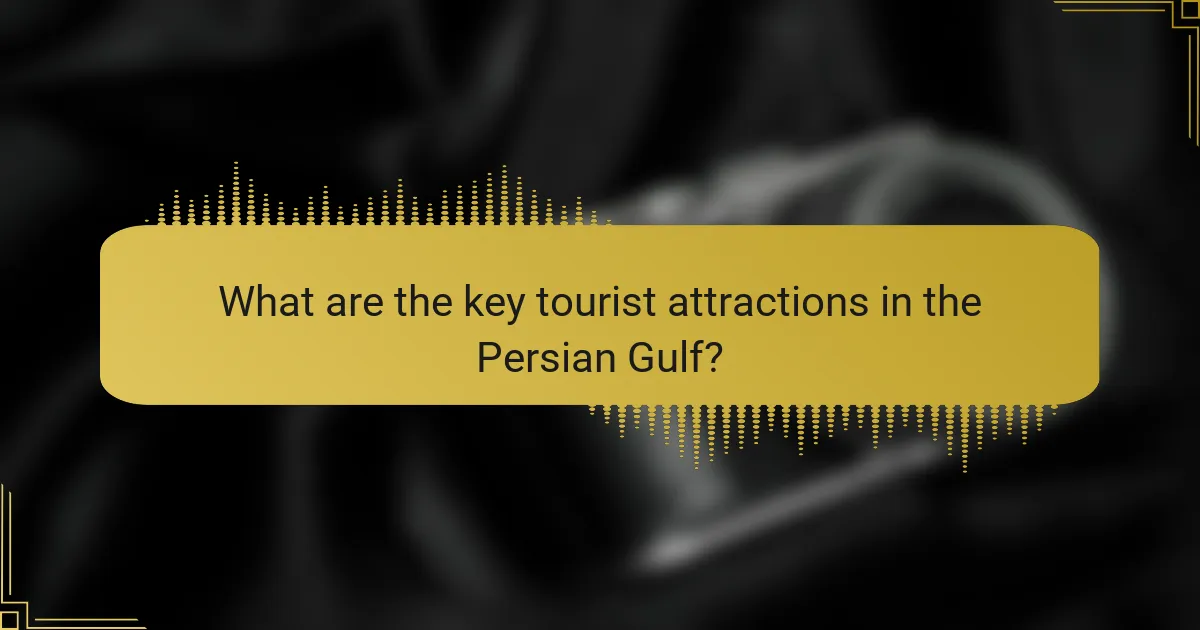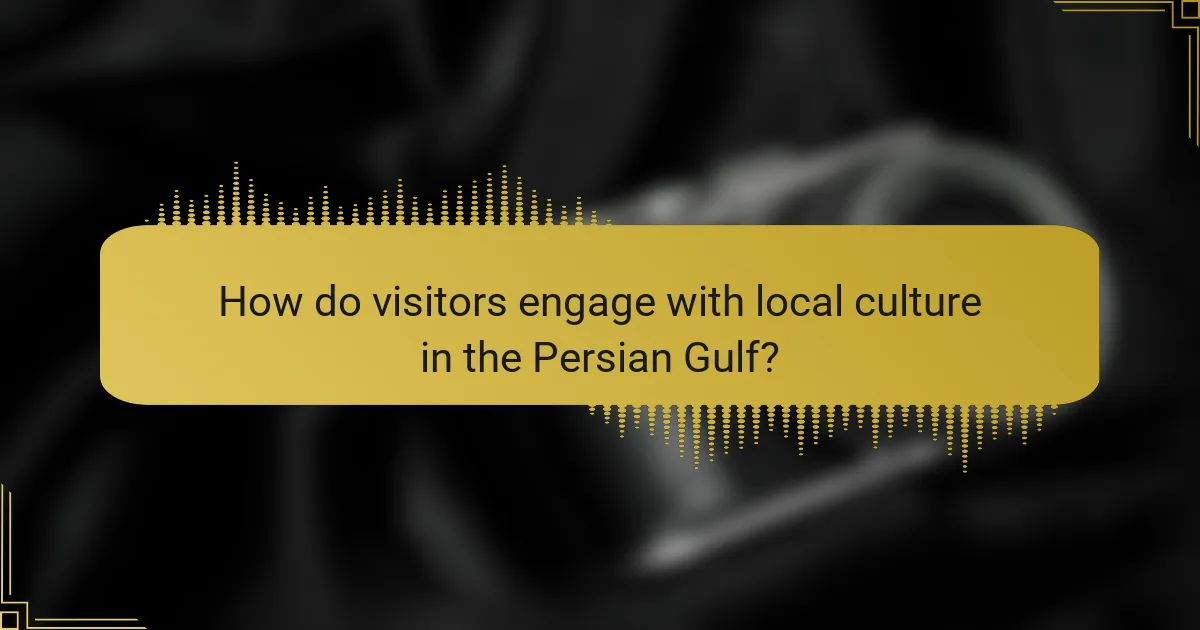The Persian Gulf region is a vibrant hub for major events that play a crucial role in boosting tourism and enhancing visitor engagement. These events not only attract a diverse audience but also stimulate local economies and foster cultural exchange, making the area a dynamic destination for both leisure and business travelers.

What are the major events in the Persian Gulf region?
The Persian Gulf region hosts a variety of major events that significantly impact tourism and visitor engagement. These events attract both local and international audiences, enhancing cultural exchange and economic activity.
Annual Formula One Bahrain Grand Prix
The Annual Formula One Bahrain Grand Prix is a premier motorsport event held at the Bahrain International Circuit in Sakhir. Typically occurring in March or April, it draws thousands of racing fans and tourists, contributing to the local economy through hospitality and entertainment sectors.
Visitors can enjoy not only the thrilling races but also a range of entertainment options, including concerts and exhibitions. Booking accommodations early is advisable due to high demand during the event.
Dubai Shopping Festival
The Dubai Shopping Festival, usually held in January and February, is a month-long retail extravaganza featuring massive discounts, entertainment, and cultural events. This festival attracts millions of shoppers and tourists, making it a key highlight in the region’s calendar.
During the festival, visitors can enjoy fireworks, live performances, and various competitions. It is an excellent opportunity for tourists to experience Dubai’s vibrant shopping scene while taking advantage of significant savings.
Qatar National Day Celebrations
Qatar National Day, celebrated on December 18, commemorates the country’s unification and independence. The day features parades, fireworks, and cultural displays, fostering national pride and attracting both residents and tourists.
Engaging in the festivities provides visitors with insights into Qatari culture and traditions. Participating in public celebrations is encouraged, as it enhances the experience of the local community’s spirit and heritage.
Abu Dhabi Film Festival
The Abu Dhabi Film Festival, typically held in October, showcases a diverse range of films from around the world, promoting cinematic arts in the region. This event attracts filmmakers, critics, and cinema enthusiasts, creating a vibrant atmosphere for cultural exchange.
Attendees can participate in screenings, workshops, and panel discussions, making it an enriching experience for anyone interested in film. Purchasing tickets in advance is recommended due to limited seating for popular screenings.
Oman’s Muscat Festival
Oman’s Muscat Festival, usually taking place in January and February, celebrates Omani culture through arts, crafts, and traditional performances. This festival attracts both locals and tourists, offering a unique glimpse into Oman’s rich heritage.
Visitors can enjoy a variety of activities, including food stalls, cultural exhibitions, and live entertainment. Engaging with local artisans and performers enhances the overall experience, making it a must-visit for those in the region during the festival.

How do major events impact tourism in the Persian Gulf?
Major events significantly enhance tourism in the Persian Gulf by attracting visitors, increasing hotel occupancy, and stimulating local economies. These events create a vibrant atmosphere that encourages both leisure and business travel, leading to a surge in tourism-related activities.
Increased hotel bookings
Major events in the Persian Gulf often lead to a substantial rise in hotel bookings as visitors flock to the region. Hotels typically experience occupancy rates that can exceed 80% during peak events, which can last from a few days to weeks. This surge necessitates advanced planning for both visitors and hotel operators to secure accommodations.
To capitalize on this trend, travelers should book their stays well in advance, especially during popular events like the Dubai Shopping Festival or the Formula 1 Grand Prix in Bahrain. Many hotels offer promotional packages during these times, providing opportunities for savings.
Boost in local economy
The influx of tourists during major events provides a significant boost to the local economy in the Persian Gulf. Increased spending on hotels, dining, entertainment, and transportation can lead to economic growth, benefiting local businesses and creating jobs. For instance, a single large event can generate millions in revenue for the host city.
Local governments often invest in infrastructure improvements and services to accommodate the increased visitor numbers, which can have long-term benefits for the community. Engaging with local vendors and attractions can enhance the visitor experience while supporting the economy.
Enhanced international visibility
Hosting major events elevates the international profile of Persian Gulf countries, showcasing their culture, hospitality, and modern infrastructure. This visibility can attract future tourists and investors, creating a lasting impact beyond the event itself. For example, the World Expo held in Dubai has significantly raised awareness of the region as a global destination.
To maximize this visibility, event organizers often leverage social media and global marketing campaigns, encouraging attendees to share their experiences online. This organic promotion can lead to increased interest in the region, making it a desirable location for future travel and investment opportunities.

What are the key tourist attractions in the Persian Gulf?
The Persian Gulf is home to several iconic tourist attractions that draw millions of visitors each year. These sites offer a blend of modern architecture, cultural heritage, and stunning landscapes, making them must-visit destinations for travelers.
Burj Khalifa in Dubai
The Burj Khalifa, standing at over 828 meters, is the tallest building in the world and a symbol of Dubai’s rapid development. Visitors can access observation decks on the 124th and 148th floors for breathtaking views of the city and beyond.
To make the most of your visit, consider booking tickets in advance, especially during peak tourist seasons. The experience includes multimedia presentations about the tower’s construction and the city’s history.
Sheikh Zayed Grand Mosque in Abu Dhabi
The Sheikh Zayed Grand Mosque is one of the largest mosques in the world and a masterpiece of modern Islamic architecture. It features 82 domes, over 1,000 columns, and exquisite chandeliers, making it a serene place for reflection and admiration.
Visitors should dress modestly and adhere to the mosque’s guidelines. Guided tours are available, providing insights into Islamic culture and the mosque’s significance, enhancing the overall experience.
Qatar Museum of Islamic Art
The Qatar Museum of Islamic Art houses a vast collection of art and artifacts spanning over 1,400 years of Islamic history. The museum’s architecture, designed by I.M. Pei, is as impressive as the exhibits it contains.
Admission is usually free, and guided tours are offered to help visitors appreciate the cultural context of the pieces. Check the museum’s schedule for special exhibitions or events that may enhance your visit.
Kingdom Centre in Riyadh
The Kingdom Centre, known for its unique design, features a sky bridge that offers panoramic views of Riyadh. It is one of the tallest buildings in Saudi Arabia and includes a shopping mall and various dining options.
To enjoy the best views, visit the sky bridge during sunset. Be aware that there may be entrance fees for the observation deck, so check in advance to plan your visit accordingly.

How do visitors engage with local culture in the Persian Gulf?
Visitors engage with local culture in the Persian Gulf through immersive experiences that highlight the region’s rich traditions and contemporary practices. These interactions often include participation in cultural festivals, savoring traditional cuisine, and exploring art exhibitions that reflect the local heritage.
Cultural festivals and events
Cultural festivals in the Persian Gulf offer visitors a vibrant glimpse into local traditions and customs. Events such as the Dubai Shopping Festival and the Abu Dhabi Festival showcase a mix of music, dance, and art, attracting both locals and tourists alike.
These festivals often feature performances by regional artists, workshops, and food stalls that allow visitors to taste local delicacies. Engaging in these events provides a deeper understanding of the cultural fabric of the Gulf states.
Traditional food experiences
Traditional food experiences are a significant aspect of cultural engagement in the Persian Gulf. Visitors can enjoy local dishes such as biryani, shawarma, and various seafood specialties that reflect the region’s culinary heritage.
Many restaurants and food markets offer cooking classes and tasting tours, allowing tourists to learn about the ingredients and cooking methods unique to the area. Trying street food or dining at a traditional majlis can enhance the cultural experience.
Art exhibitions and installations
Art exhibitions and installations in the Persian Gulf highlight both contemporary and traditional artistic expressions. Cities like Doha and Dubai host galleries and museums that feature works from local and international artists, often focusing on themes relevant to the region.
Engaging with art in this context can involve guided tours, artist talks, and interactive installations that encourage visitor participation. This not only fosters appreciation for the art but also connects visitors with the cultural narratives of the Gulf states.

What are the tourism trends in the Persian Gulf?
The Persian Gulf is experiencing notable tourism trends, including a shift towards eco-tourism, a rise in luxury travel, and an increased interest in cultural heritage. These trends reflect changing traveler preferences and the region’s efforts to diversify its tourism offerings.
Rise of eco-tourism
Eco-tourism in the Persian Gulf is gaining traction as travelers seek sustainable experiences that minimize environmental impact. Destinations are promoting natural reserves, wildlife sanctuaries, and eco-friendly resorts that highlight the region’s unique ecosystems.
Visitors can engage in activities such as bird watching, snorkeling in coral reefs, and exploring desert landscapes. Countries like Oman and the UAE are investing in eco-friendly infrastructure to attract environmentally conscious tourists.
Growth in luxury travel
The luxury travel sector in the Persian Gulf is booming, driven by affluent travelers seeking high-end experiences. This includes lavish resorts, exclusive dining options, and personalized services that cater to individual preferences.
Destinations like Dubai and Abu Dhabi are home to some of the world’s most luxurious hotels and shopping experiences. Travelers can expect to find private villas, yacht charters, and bespoke tours that enhance their stay.
Increased interest in cultural heritage
There is a growing interest in cultural heritage tourism within the Persian Gulf, as visitors seek to connect with the region’s rich history and traditions. This trend is evident in the popularity of museums, historical sites, and cultural festivals.
Countries are promoting their heritage through initiatives like UNESCO World Heritage sites and cultural events that showcase local art, music, and cuisine. Engaging in guided tours and workshops can provide deeper insights into the region’s diverse cultures.
